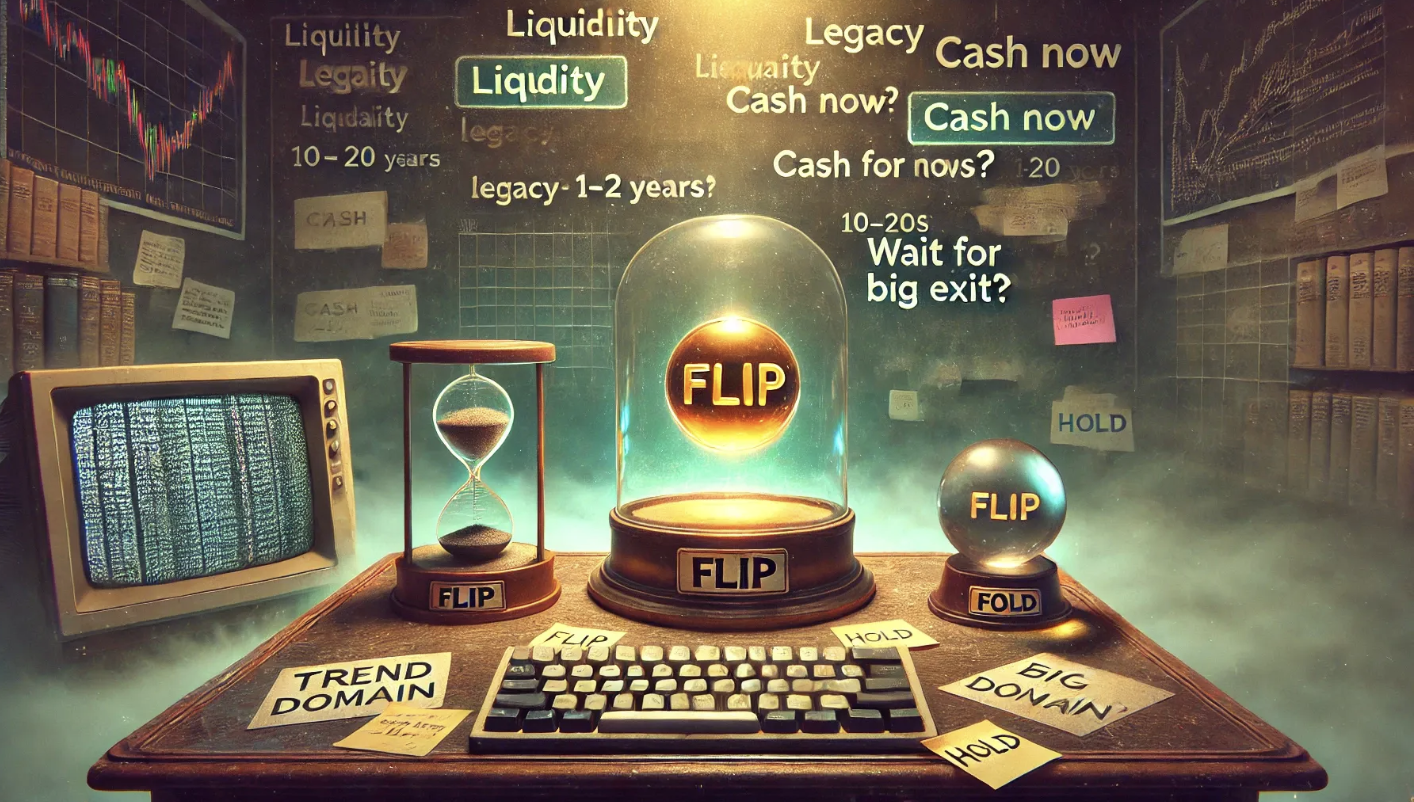Holding vs. Flipping: How Long Should You Keep a Domain?

Ask any domain investor and you’ll hear both sides of the same debate. Some swear by quick flips, taking modest profits and moving on. Others argue that patience is where the real money is made, pointing to legendary sales, like Whisky.com, which paid off after years of holding.
The truth lies somewhere in between. How long you should keep a domain depends on the type of name, the strength of the market, and your own investment strategy. A one-size-fits-all answer does not exist, but patterns emerge when you study sales data and market behavior.
The Case for Flipping
Flipping is attractive to some people because it generates liquidity. If you hand-register a domain for $12 and resell it for $500 within a year, you’ve made a strong return without tying up capital for decades. Quick flips also reduce exposure to renewal fees, market downturns, and shifting trends.
Best suited for:
- Trend domains: Names tied to fast-moving industries (NFTs, Web3, Metaverse). Trends can spike overnight, but they fade just as quickly.
- Two-word brandables: Short combinations like BrightLabs.com or FinCore.com often move faster than one-word generics because startups need them now, not in 10 years.
- Expired domain flips: Buying at auction and selling within 6–12 months is a common play.
Data from NameBio suggests that a large percentage of brandable sales happen within the first 1–3 years of registration. Timing matters: if you miss the peak of a trend, a quick flip opportunity may evaporate.
The Case for Holding
Premium domains are like fine wine; they appreciate with age. Holding allows you to benefit from compound demand. As industries mature, as new companies form, and as capital flows into digital real estate, the value of category-defining names increases.
Best suited for:
- One-word .coms: Names like Crypto.com, Whisky.com, or Voice.com only get rarer. They often take years or decades to reach maximum value.
- Industry generics: Insurance.com sold for $35 million because it was the definitive name in a massive market. Patience was key.
- Short acronyms: Investors who held onto 2–4 letter domains saw explosive appreciation once demand from China surged in the mid-2010s.
Historical sales show that many of the most valuable transactions involved long hold periods. Whisky.com was registered in 1995 and sold nearly two decades later for $3.1 million. Voice.com sold for $30 million after 25 years of ownership.
The Hidden Costs of Holding
Holding is not free. Every year you pay renewals, often $10–$20 per domain, which adds up across large portfolios. For premium names, renewals can run into the hundreds. Liquidity risk is also real. A domain can tie up capital for years without producing income, unless you monetize through parking or leasing.
There is also opportunity cost. A $50,000 offer on a brandable today could fund dozens of new acquisitions. If you hold out for $250,000 in 10 years, you may actually underperform compared to flipping and reinvesting.
Taxes matter too. A quick flip usually triggers short-term capital gains, which are taxed at higher ordinary income rates. If you hold a domain for over a year, gains are typically taxed at the lower long-term capital gains rate. Depending on your situation, the difference between cashing out fast and waiting can be significant after the IRS takes its cut.
The Middle Path: Strategic Patience
Most successful investors combine both strategies. They flip smaller names to generate cash flow while holding premium assets for the long game. The key is to match hold periods to domain types.
- Trends: 1–2 years → Sell while the hype lasts.
- Two-word brandables: 2–5 years → Startups launch in cycles, so demand is steady but not infinite.
- Category one-words: 10–20 years → These are legacy plays that only grow in value.
- Acronyms: 5–15 years → Driven by regional and cultural demand spikes.
Think of it like portfolio management. Not every asset is a 20-year hold, and not every name should be flipped within 12 months.
Lessons from the Market
- Liquidity vs. Legacy: Flipping generates cash, holding generates outsized wins.
- Know your domain type: Trends fade, but generics last forever.
- Calculate renewal math: Holding only makes sense if potential appreciation outpaces carrying costs.
- Take the bird in hand: Sometimes selling at 3–5x return is smarter than holding for a hypothetical 20x.
Final Thoughts
The question is not whether to hold or flip, but how to balance both approaches. Domain investing is part art, part timing, and part psychology. Quick flips can fuel growth, but legendary wins come from patience.
The best investors are not rigid. They know when to cash out and when to dig in. If you treat your domains as a portfolio with different time horizons, you give yourself the flexibility to capture both the fast wins and the generational jackpots.




